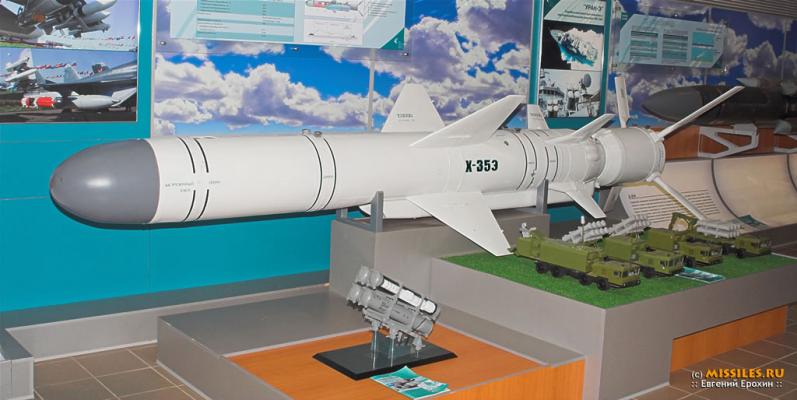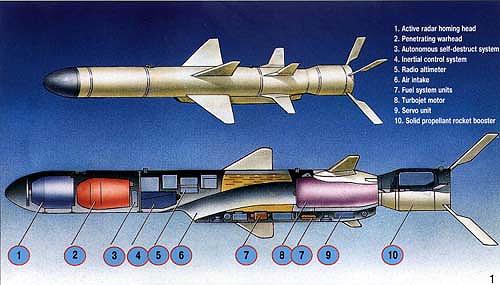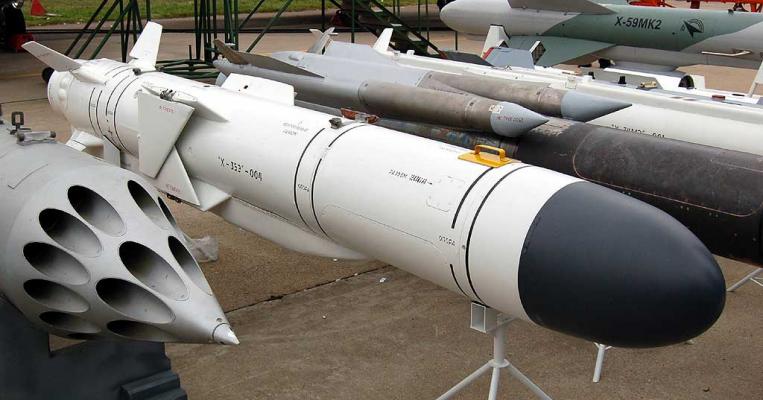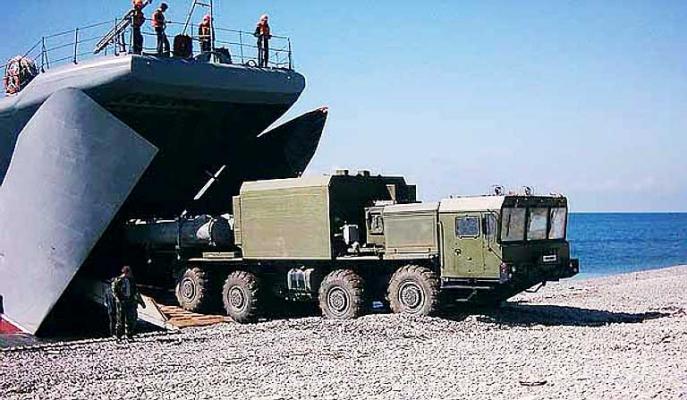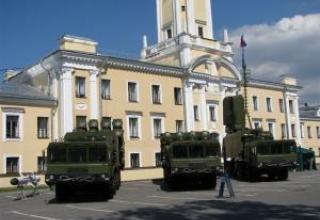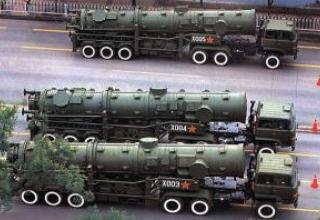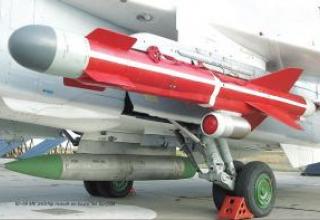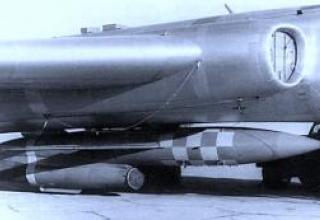The development of "Uranus" ship complex with X-35 cruise missile for arming small boats and ships of medium displacement was set by the Decree of the USSR CM and CPSU Central Committee on April 16, 1984. The head enterprise is the developer of the Design Bureau "Zvezda". (currently part of the Tactical Missile Arms Corporation), chief designer - G.I.Khokhlov.
The X-35 missile (factory number 3M24) is designed to destroy combat (landing) surface ships and transport vessels from the shock groups (convoys) or the following single displacement of up to 5000 tons and is similar in design to the American PKR AGM-84 "Harpoon". The missile is designed for combat use day and night, in any weather conditions, with intense interference and fire countermeasures of the enemy. It can be used either alone or in a salvo.
On the basis of the X-35 except for the ship complex "Uranus" created - Coastal anti-ship complex "Ball", as well as an aircraft version (two modifications: for aircraft X-35U and helicopters X-35V). The helicopter version of the missile can be used with Ka-27 and Ka-28 helicopters, the aircraft version - with MiG-29K, MiG-29SMT, Su-30MK, Su-35, Yak-141 fighters, Su-24M front bomber, Tu-142M anti-submarine aircraft and other carriers. A version of the complex with a missile in a standard 20-foot container designated Club-K was demonstrated at the MMMS-2011 in St. Petersburg (see photo 1, photo 2, photo 3, photo 4). The complex is designed and manufactured by Concern Morinformsystem-Agat JSC in cooperation with Typhoon JSC and Tactical Missile Arms Corporation.
At present, Tactical Missile Armament Corporation offers the above complexes to include the upgraded X-35UE rocket (see photo), which has improved combat efficiency and a range of up to 280 km. X-35UE is universal and can be used not only for installation on aircraft carriers, but also in "Uran-E" anti-ship missile complexes and "Bal-E" anti-ship ground-based missiles.
JSC "Concern Radioelectronic Technologies" in 2015. announced the possibility of placing the X-35UE missile on board the deck version of the Ka-52K helicopter in the case of modernization of the onboard radar. This will increase the range of target detection by the helicopter in 2 times, which is almost 200 km.
In the west, the missile was designated AS-X-20 Harpoonsky .
For the first time the rocket was openly demonstrated in 1992 at the aviation exhibition "Mosaeroshow-92" in Moscow.
X-35 ship-based missiles are delivered to India and Vietnam.
Composition:
The X-35 missile (see projections) is made according to the normal aerodynamic scheme and has an X-shaped folding wing and plumage of large elongation. The lower part of the hull has a trapezoidal cross-section air inlet. Small-size turbojet engine running on aviation kerosene is used for the marching flight. Winged missile in the ship and helicopter versions is equipped with a folding cross-shaped large elongation and the starting solid fuel accelerator, located in tandem with the march. In the helicopter version, the RDTT has a smaller total pulse.
The guidance system on the final section of the trajectory is an active radar, capable of working under conditions of electronic counteraction. Onboard control system with combined (inertial, active radar) guidance system and radio altimeter allows the missile to fly to the target at extremely low altitudes with high subsonic speed. There is a version of the missile with a thermal imaging CNS.
The ARGS-35 homing radar head (see photo) was developed by OJSC SPE "Radar MMS". It provides: detection of a surface target, the choice of the target to be hit, determining the target position by the azimuth (bearing) and angle of position, range (distance) to the target and the speed of approaching the target, issuing target coordinates in the guidance system of the missile. The GSN head fairing is made of EDT-10kv glass textolite (developer - Research Institute of Nonmetallic Materials, manufacturer - Research and Production Enterprise "Technology" Obninsk). The fairing with the weight of 2 kg provides: angular errors - not more than 25', radio transparency - not less than 85%.
The control system of the modernized X-35UE rocket is supplemented by the satellite navigation system and a new active-passive radar GOS. The maximum detection and target acquisition range of the X-35UE is 50 km. The flight range of Kh-35UE is increased to 260 km. The missile has received fundamentally new qualities: four points of change of the route, the possibility of rounding the islands, attacking targets in the narrow areas, fjords and coastal strip.
The penetrating shrapnel-flammable warhead of the missile allows reliably hitting surface ships with displacement up to 5000 tons. The missile's combat efficiency is increased by flying at extremely low altitudes (3-5 m depending on the wave height), which makes it much more difficult to intercept by ship-based missile systems, and by the fact that the missile is launched without the entry of the carrier into the air defense zone of the attacked ships (see application areas). The monitoring of the missile's condition, the entry of the flight mission and the launch operations are automated, and the preparation time for cold launch is 60 seconds.
For the aviation version of the X-35 missile aircraft launchers are used (ACS), which are designed for reliable attachment of the PCR to the carrier and to ensure communication of onboard control system equipment with aircraft or helicopter instruments of guidance and provision of the missile. As a RCE can be used RCE-78 or ACU-58.
The main advantages of the X-35 missile can be attributed:
- The low altitude of the flight provides a discreet approach of the PCR to the attacked ship, which causes difficulties in its detection and defeat by the ship's air defense;
- the small size of the missile reduces its EPR;
- the considerable ammo of X-35 missiles on the carrier (8-16 missiles) does not require a large number of them;
- possibility to shoot in volley (3s. interval) allows to increase the probability of enemy ship defeat;
- combined control system (inertial + active radar) reduces the visibility of the ICR on the initial flight section and increases its stability in combat;
- possibility to engage ships of different classes: corvette, destroyer, missile boat, etc. (up to 5000t displacement);
- delivery of X-35 from the manufacturing plant to the TIC provides a quick and safe replacement in the base;
- use of the new control system, processing and display of information allows to hit effectively warships and enemy transports;
- large reserve for modernization, for example, the use of more energy-intensive fuel allows to significantly increase the flight range.
The main drawbacks are:
- Insufficient flight range at which the risk of the carrier entering the air defense zone remains;
- relatively low flight speed increases the probability of an air defense missile being hit by an attacking ship.
- the management system does not allow for the targeting of coastal and ground targets.
Uranus-E ship missile system
Uranium-E" SLC with X-35 missile is designed to engage high-speed missile, torpedo and artillery boats, as well as surface ships, transports (displacement up to 5000t.) of convoys and landing units of the enemy, acting in groups or alone in the conditions of REP and fire suppression.
Composition of the complex:
- X-35 anti-ship cruise missile
- transport start-up container
- launcher
- ship's automated control system (see CASU composition)
- ground-to-ground kit
The complex is designed to be placed on new frigates, corvettes, missile boats, as well as on ships of Russian and foreign construction during their modernization. For example, Uranium-E can be used on the new missile boat of Project 20970 "Katran" developed by the Central Design Bureau "Almaz". Due to the use of the Uranium-E Ship-to-Ship APC with 8 anti-ship missiles 3M24E (X-35) in two launchers, the striking power of the Katran increases by more than 3 times compared to the Project 205 (205ER) boat. Target designation for surface targets is provided by the 3C25E radar system with active and passive target designation modes. A considerable number of X-35E missiles on the carrier (8-16 missiles) with a short launch interval provides a massive approach to the target at extremely low altitudes.
On the missile boat of project 1241.8 (displacement of 510 tons, speed 40 knots.) installed 16 missiles complex "Uranium-E", grouped into four packages (see photo). Targeting is performed by the marine electronic system "Harpoon-Bal". Uranium-E" SLCMs can be installed on patrol ships of Project 11541 "Corsair" and on the latest Russian export corvettes A-1700.
The advertising passport for the small missile ship of project 21632 "Tornado" (approved on 26.04.2008) indicates the possibility of placing the "Uran-E" complex as one of the weapon options.
The launcher of the complex 3C-24E, provides not only the launch of rockets and storage on the ship, but also their shockless loading to the ship when the sea waves. It also reduces to an acceptable level for the missile running, impact and impulse overloads, arising, for example, in the case of an explosion near the ship mines, bombs and other weapons.
The launcher is a welded frame with the upper surface having the elements for the placement and fixation of the TPK unit, and the lower surface having funnel-shaped catchers that interact with the fixed on-deck supports when the frame is loaded from the TPK unit to the ship. The supports serve for installation and fixation of the frame in a certain place of the ship and are equipped with spring shock-absorbing devices, which reduce overloads on the rocket during the operation and installation of the TPK unit on the ship. Electric harnesses included in the PU connect the onboard missile control system with the ship's launch control and management system.
The X-35 missile is placed in a transport and launch container, which is a metal cylinder with internal guides. From the ends it is closed by lids, which are opened by the spring mechanism after triggering the pyrobolts. In its central part there are rectangular bends, which serve to unite the transport and discharge container in bags and fix them to the starting unit. After the missile is used, the container can be reused after rehabilitation work.
The launcher is fixed on a foundation at an angle of 35° from the horizontal plane of the ship. Each launcher is designed to accommodate four missiles in transport and launch containers. The launcher may also include a device for placing a container package on the launcher.
Control of the state of the missiles, their preparation for launch, reception, processing and input of target designation before firing are made by the ship's automated control system. This system is designed as two containers covering an area of 15 and 5 square metres, respectively. Inside the first one there is a central control unit, an analog input unit and a power source control unit, inside the second one there is an energy part including two communication devices with launchers and missiles, two connecting boxes and a converter.
To prepare missiles for use, as well as to carry out rehabilitation and lifting operations, there is a set of ground equipment, which includes an automated missile control system, a set of technological equipment, a set of lifting devices, transport trolleys, fuel tanker, air refueler, transport vehicles and a crane. The ground equipment complex is located on the shore, forming an autonomous technical position for servicing missiles and transport and launch containers. The rest of the "Uranium" complex elements are placed on the carrier.

Uranium-E" complex corresponds to the world standards, and according to "cost-effectiveness" criterion it is optimal for solution of combat tasks at sea by tactical-class missiles.
The use of missiles on various carriers (ship, plane, helicopter, coastal complex) without the need for radical modernization in the modern market is important. Interconnection with any ground complex (radar "Positive", "Harpoon-Bal", 3C25E, etc.) in combination with the modular-maintain principle of the instrument hierarchy (which is now given great importance, with the purpose of subsequent modernization) allows you to complete the equipment in different configurations.
In general, from the economic point of view, the design of the X-35 anti-ship missile is very successful. In comparison with foreign analogues, complexes with this PCR differ in comparatively low cost in combination with high efficiency. However, when advancing on international markets, they will inevitably face strong competition, as this niche has long been occupied: the American PCR "Harpoon" - produced in several countries around the world and already by 1990 they were produced over 5000; French PCR "Exocet", well recommended during the conflict in the Falkland Islands.
Bal-E coast missile system
DBK "Bal-E" (see description) is intended for control of territorial waters and strait zones, protection of naval bases, coastal facilities and infrastructure of the coast, protection of the coast in land-hazardous directions. The complex provides detection and tracking of surface targets; target distribution and hitting of accompanied targets by anti-ship cruise missiles X-35. The combat application of the complex is provided in simple and difficult weather conditions day and night with full autonomy of guidance after launch in the conditions of fire and electronic counteraction of the enemy.
Characteristics:
| X-35 missile | |
| Start range, km | 7-130 (7-260 for X-35UE) |
| The height of flight over the ridges of the waves, m: - on the march - haunting |
10-15 4 |
| Possible rotation angle from the course line, deg | ± 90 (± 130 for Х-35UE) |
| Starting weight, kg - ship-to-shore - basing option |
600 520/610 |
| Weight of combat unit, kg | 145 |
| Guidance accuracy (KBO), m | 4-8 |
| Flight Speed, m/s | 270-280 |
| Width of use, deg | from 75° North Latitude to 75° South Latitude. |
| The dimensions of the rocket, m - booster length - case diameter - wingspan |
3.85 (4.4) 0.42 1.33 |
| Radar CNS ARS-35 | |
| Horizontal view angle, deg | between -45 and +45 |
| Azimuth angle, deg | between +10 and -20 |
| Range, km | 20 (50 for Х-35UE) |
| Weight, kg | 40-47,5 |
| Diameter, mm | 420 |
| Length, mm | 700 |
| Restrictions on the use of CNS: - precipitation, mm/s - sea disturbance, scores - usage temperature, C |
up to 4 up to 6 -50°C to +50°C |
| Aircraft launcher | |
| Type | APU-78 or ACU-58 |
| Number of rockets per PU | 1 |
| Weight of empty PU, kg | 185 |
| Dimensions PU, mm - length - width - altitude |
3810 130 220 |
| Conditions of launch from the plane: - altitude, m - speed,M |
200-10000 0.35-0.9 |
| Conditions for launching from a helicopter: - altitude, m - speed,M |
200-3500 0-0.25 |
Testing:
According to data dated July 2018, the Soviet side sold the rockets and other components of the Hurricane system (it is worth understanding the Hurricane MLRS) to the Syrian side. Some of these rockets were handed over to the Hezbollah movement in the early 2000s.
In 2002, Alyazhedinov Vadim Rashitovich, Skirda Viktor Andreevich was awarded the S.I. Mosin Prize for his work on the topic: "The Hurricane multiple launch rocket system with increased accuracy and heap of fire.
Sergei Sivtsov - designer of control system elements. He made a significant contribution to the development of correcting switchgears for the angular stabilization systems of Smerch and Uragan Rocket Launcher Systems. He took direct part in working out of the given elements, tests and their introduction in a batch production.
Sources:
- Голубев И.С., Самарин А.В., Новосельцев В.И., Конструкция и проектирование летательных аппаратов, М.: Машиностроение, 1995г.
- Энциклопедия современного вооружения, СПб.: Полигон-Аст, 1997г.
- Военная авиация, Мн.: издательство "Попурри", 1999г.
- Оружие России, М.: издательский дом «Военный парад», 2000г.
- Карпенко А.В., Ганин С.И., "Отечественные авиационные тактические ракеты" 1999г.
- Бастион №1,2000г.
- «Военный парад», №4,5 2000, №6 2001г, №5 2002г
- Зарубежное военное обозрение, №1,2 1989г, №12 1987г
- http://www.militarynews.com
- ОАО Концерн "Гранит-Электрон"
- Ракета Х-35УЭ
